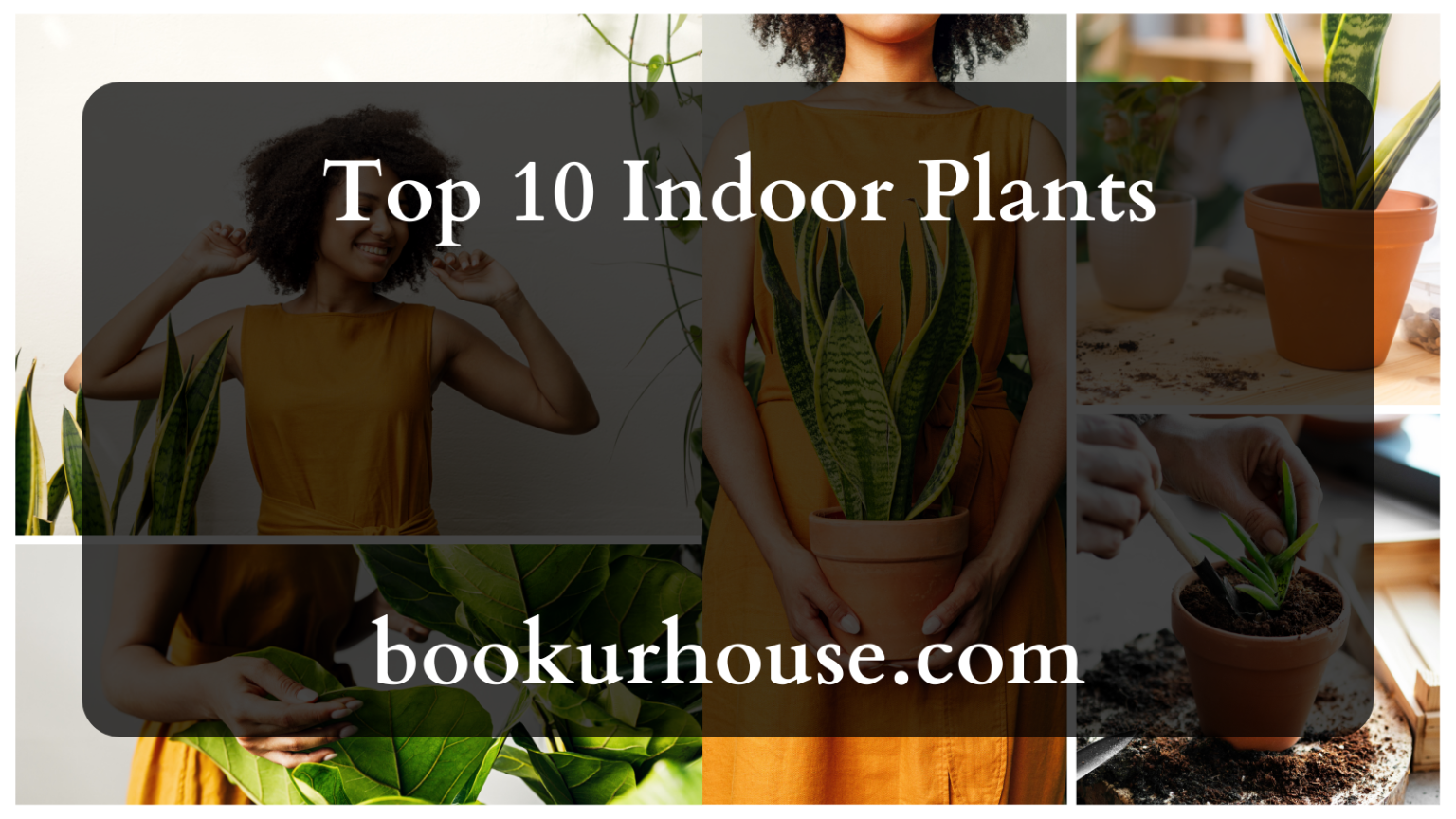Introduction
In the present high-speed world, the significance of bringing nature inside couldn’t possibly be more significant. Indoor plants add a bit of vegetation to your living space and offer various medical advantages, including further developing air quality, decreasing pressure, and supporting temperament. Whether you’re a carefully prepared plant devotee or a fledgling hoping to integrate vegetation into your home, here are the Top 10 Indoor Plants that make certain to flourish and improve your indoor climate.
Here are the Top 10 Indoor Plants that make certain to flourish and improve your indoor climate:
Snake Plant
Known for its strength and air-filtering characteristics, the snake plant is famous for indoor spaces. It requires negligible support and can flourish in low-light circumstances, making it ideal for workplaces and rooms. The tall, blade-molded passes add a hint of tastefulness to any room while successfully sifting through poisons from the air.
Spider Plant
With its flowing foliage and simple consideration nature, the spider plant is an excellent decision for novices. It flourishes in splendid, circuitous light and can endure periodic disregard. Spider plants are known for eliminating poisons like formaldehyde and carbon monoxide from the air, making them ideal for homes and workplaces.
Peace Lily
Eminent for its striking white sprouts and air-refining properties, the Peace lily adds a hint of polish to any indoor space. It flourishes in low to direct light circumstances and favors reliably damp soil. Peace lilies successfully eliminate poisons like benzene, trichloroethylene, and smelling salts from the air, making them a famous decision for rooms and parlors.
ZZ Plant
If you’re searching for a low-support plant that blossoms with disregard, the ZZ plant is a brilliant choice. It highlights shiny, dull green foliage that adds a cutting-edge touch to any inside. ZZ plants are profoundly lenient toward low light and inconsistent watering, making them ideal for occupied people or those with restricted cultivating experience.
Pothos
Flexible and simple to focus on, pothos is a famous decision for fledgling and experienced plant devotees. Its following plants and heart-molded passes make it an appealing expansion to racks, ledges, or hanging crates. Pothos plants flourish in low to direct light circumstances and can endure times of dry spells, making them ideal for occupied families.
Rubber Plant
The Rubber plant adds a hint of show to any indoor space with its enormous, polished leaves and striking appearance. It favors splendid, aberrant light and requires well-depleting soil to flourish. Rubber plants are compelling at eliminating poisons like formaldehyde from the air, making them a valuable expansion to homes and workplaces.
Philodendron
Accessible in various shapes, sizes, and varieties, philodendrons are adaptable plants that are not difficult to focus on and engender. They flourish in moderate to splendid backhanded light and favor marginally sodden soil. Philodendrons are phenomenal air purifiers and can assist with further developing indoor air quality while adding visual interest to your home.
Aloe Vera
Valued for its therapeutic properties, aloe vera isn’t just a lovely expansion to your indoor nursery. Still, it is also a helpful plant to have nearby for minor consumption and skin disturbances. It flourishes in brilliant, backhanded light and requires well-depleting soil. Aloe vera plants are not complex to focus on and can go for extended periods without watering, making them ideal for careless nursery workers.
Boston Fern
The Boston Fern adds a dash of tropical energy to any indoor space with its lavish, padded fronds. It inclines toward splendid, aberrant light and high moistness levels, making it ideal for washrooms or kitchens. Boston Fern is a great air purifier and can assist with eliminating toxins like formaldehyde and xylene from the air, advancing a better indoor climate.
Chinese Evergreen
Known for its striking foliage examples and low upkeep prerequisites, the Chinese evergreen is a famous decision for indoor nurseries. It flourishes in common to direct light circumstances and favors somewhat soggy soil. Chinese evergreens are viable at eliminating poisons like benzene and formaldehyde from the air, making them an essential expansion to any home or office.
Integrating indoor plants into your residence space is an essential and compelling method for upgrading both the stylish allure and, by and large, prosperity of your home. Whether you’re searching for air-cleaning properties, low upkeep necessities, or adding a bit of vegetation to your environmental factors, the leading 10 indoor plants referenced above address your issues. So why stand by? Bring the excellence of nature inside today and receive the invaluable rewards that indoor plants bring to the table.
FAQs
What are the best indoor plants?
Easy-to-care-for plants like the Snake Plant, Spider Plant, or Pothos are great options for beginners. They require minimal maintenance and can thrive in various conditions.
Which indoor plants are best for purifying the air?
Many indoor plants, including the Peace Lily, Snake, and Spider Plant, are known for their air-purifying qualities. These plants can help remove toxins and improve air quality.
What indoor plants are safe for pets?
While many indoor plants are safe for pets, some can be toxic if ingested. Secure options include the Spider Plant, Boston Fern, and Areca Palm. It’s essential to research each plant’s toxicity level before introducing it to your home.
How can I keep my indoor plants healthy?
To keep your indoor plants healthy, ensure they receive adequate sunlight, water them regularly (but don’t overwater), and periodically prune them to remove dead or dying leaves. Additionally, use well-draining soil and consider adding a layer of mulch to retain moisture.
What are the best indoor plants for low-light conditions?
Consider plants like the ZZ, Snake, or Peace Lily for low light conditions. These plants can tolerate low light levels and are relatively easy to care for.
How often should indoor plants be watered?
Watering frequency depends on various factors, including the type of plant, its size, and the conditions in your home. Generally, it’s best to water indoor plants when the top inch of soil feels dry. Avoid overwatering, as it can lead to root rot.
Can indoor plants help reduce stress?
Yes, indoor plants have been shown to reduce stress levels and improve overall mental well-being. The act of caring for plants can be therapeutic, and the presence of greenery can create a calming environment.
Which indoor plants are best for improving sleep?
Plants like Lavender, Jasmine, and Aloe Vera are known for their calming properties and can help promote better sleep. Placing these plants in your bedroom can create a more relaxing atmosphere conducive to restful sleep.
What are some easy-to-care-for indoor plants?
Easy-to-care-for indoor plants include the Snake Plant, Spider Plant, Pothos, and Peace Lily. These plants require minimal maintenance and can thrive in various indoor conditions.
Are there any indoor plants that require minimal sunlight?
Yes, plants like the Snake, ZZ, and Spider Plant can tolerate low light conditions and are suitable for spaces with minimal sunlight. However, they may not grow as quickly or bloom as readily as plants that receive more sunlight.
Conclusion
Indoor plants enhance the aesthetic appeal of your living space and provide numerous health benefits. These green companions can significantly improve your overall well-being, from purifying the air to reducing stress levels. Whether you’re a seasoned gardener or a novice, there’s a perfect indoor plant for everyone. Consider incorporating some of these top 10 indoor plants into your home to enjoy their beauty and advantages.












